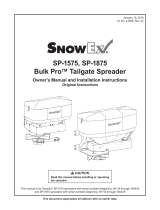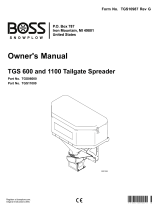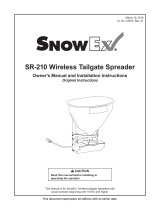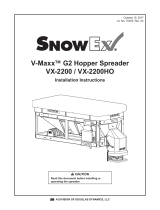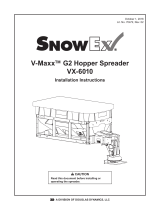
CAUTION
Read this manual before installing or
operating the spreader.
January 1, 2020
Lit. No. 95362, Rev. 07
95330
Low-Profi le Tailgate Spreader
Model 500
Owner's Manual
This manual is for WESTERN® Model 500 Low-Profi le Tailgate Spreaders
with serial numbers beginning with 030101 and higher.
This manual supersedes all editions with an earlier date.


Lit. No. 95362, Rev. 07 3 January 1, 2020
Register your spreader online at www.westernplows.com
Owner Name: ______________________________________________________________________________
Date Purchased: ____________________________________________________________________________
Outlet Name: _______________________________________________ Phone: _________________________
Outlet Address: _____________________________________________________________________________
Vehicle Model/Year: _________________________________________________________________________
Spreader Type/Size (model): _________________________________________ Weight: ______________ lb/kg
Spreader Serial Number:______________________________________________________________________
SPREADER OWNER DATA SHEET


Lit. No. 95362/95363, Rev. 07 5 January 1, 2020
TABLE OF CONTENTS
SPREADER OWNER DATA SHEET ....................... 3
PREFACE ................................................................... 6
SAFETY ..................................................................... 7
Safety Defi nitions .................................................. 7
Safety Precautions ................................................7
Fuses .................................................................... 8
Personal Safety..................................................... 8
Fire and Explosion ................................................ 8
Cell Phones ........................................................... 8
Ventilation ............................................................. 8
Battery Safety ....................................................... 8
Noise ..................................................................... 8
Torque Chart ......................................................... 9
Warning/Caution Labels ..................................... 10
LOADING ................................................................. 11
Certifi cation ......................................................... 11
Approximate Material Weights ............................ 11
Material ............................................................... 11
MOUNTING THE SPREADER ............................... 12
Receiver Mount Spreader ................................... 12
OPERATING THE SPREADER ............................. 13
Driving and Spreading on Snow and Ice ............ 13
Variable Speed (PWM) Control – New Style ...... 14
Starting and Stopping the Motor .................. 14
Adjusting the Spinner Speed ........................ 14
BLAST/Maximum Speed .............................. 14
Diagnostic Indicator Light ............................. 14
Variable Speed (PWM) Control – Old Style ........ 15
Starting and Stopping the Motor .................. 15
Adjusting the Spinner Speed ........................ 15
BLAST/Maximum Speed .............................. 15
Spinner Indicator Lights ................................ 15
ON/OFF Control .................................................. 16
Starting and Stopping the Motor .................. 16
BLAST/Maximum Speed .............................. 16
REMOVING THE SPREADER ............................... 17
Removing the Receiver Mount Spreader ............ 17
MAINTENANCE ...................................................... 18
Cleaning .............................................................. 18
Preseason Check................................................ 18
Postseason Maintenance.................................... 18
Drive Belt Replacement ...................................... 19
Bearing and Set Screw Maintenance ................. 19
Recycle ............................................................... 19
4-PIN HARNESS WIRING DIAGRAM .................. 20
TROUBLESHOOTING GUIDE ............................... 21

Lit. No. 95362/95363, Rev. 07 6 January 1, 2020
PREFACE
This manual has been prepared to acquaint you with
the safety information, operation, and maintenance of
your new spreader. Please read this manual carefully
and follow all recommendations. This will help ensure
profi table and trouble-free operation of your spreader.
Keep this manual accessible. It is a handy reference in
case minor service is required.
When service is necessary, bring your spreader to
your local outlet. They know your spreader best and
are interested in your complete satisfaction.
NOTE: This spreader is designed to spread snow
and ice control materials only. Do not use it
for purposes other than those specifi ed in this
manual.

Lit. No. 95362/95363, Rev. 07 7 January 1, 2020
WARNING
Vehicles <10,000 lb GVWR: Obstructing the
visibility from the vehicle's rear camera could
result in serious injury or damage. An auxiliary
camera system shall be installed if the
vehicle's rear camera is removed or blocked.
NOTE: Lubricate grease fi ttings after each use.
Use a good quality multipurpose grease.
CAUTION
Disconnect electric and/or hydraulic power
and tag out if required before servicing or
performing maintenance.
CAUTION
DO NOT leave unused material in hopper.
Material can freeze or solidify, causing unit to not
work properly. Empty and clean after each use.
SAFETY
SAFETY DEFINITIONS
NOTE: Indicates a situation or action that can lead
to damage to your spreader and vehicle or other
property. Other useful information can also be
described.
SAFETY PRECAUTIONS
Park the vehicle on a level surface, place shift lever in
PARK or NEUTRAL, and set the parking brake. Turn
OFF the engine and remove the key.
WARNING
Indicates a potentially hazardous situation
that, if not avoided, could result in death or
serious personal injury.
CAUTION
Indicates a potentially hazardous situation
that, if not avoided, may result in minor to
moderate injury. It may also be used to alert
against unsafe practices.
WARNING
• Driver to keep bystanders minimum of
25 feet away from operating spreader.
• Before working with the spreader, secure all
loose-fi tting clothing and unrestrained hair.
• Before operating the spreader, verify that all
safety guards are in place.
• Before servicing the spreader, wait for
conveyor or spinner to stop, then lock out
power.
• Do not climb into or ride on spreader.
WARNING
Overloading could result in an accident or
damage. Do not exceed GVWR or GAWR
ratings as found on the driver-side vehicle
door cornerpost. See Loading section to
determine maximum volumes of spreading
material.
CAUTION
If rear directional, CHMSL light, or brake
stoplights are obstructed by the spreader, the
lights shall be relocated, or auxiliary directional
or brake stoplights shall be installed.
CAUTION
• Do not operate a spreader in need of
maintenance.
• Before operating the spreader, reassemble
any parts or hardware removed for cleaning
or adjusting.
• Before operating the spreader, remove
materials such as cleaning rags, brushes,
and hand tools from the spreader.
• While operating the spreader, use auxiliary
warning lights, except when prohibited by law.
• Tighten all fasteners according to the
Torque Chart. Refer to Torque Chart for the
recommended torque values.
WARNING
Do not install the control for this product in
the deployment path of an air bag. Refer to
vehicle manufacturer's manual for air bag
deployment area(s).
CAUTION
During the hopper installation we recommend
the addition of an OSHA compliant backup
alarm. This alarm is required for OSHA
governed employers.

Lit. No. 95362/95363, Rev. 07 8 January 1, 2020
CELL PHONES
A driver's fi rst responsibility is the safe operation of the
vehicle. The most important thing you can do to prevent
a crash is to avoid distractions and pay attention
to the road. Wait until it is safe to operate Mobile
Communication Equipment such as cell phones, text
messaging devices, pagers, or two-way radios.
VENTILATION
BATTERY SAFETY
NOISE
Airborne noise emission during use is below 70 dB(A)
for the spreader operator.
SAFETY
CAUTION
Batteries normally produce explosive gases
that can cause personal injury. Therefore,
do not allow fl ames, sparks, or lit tobacco
to come near battery. When charging or
working near a battery, always cover your
face and protect your eyes, and also provide
ventilation.
• Batteries contain sulfuric acid that burns
skin, eyes, and clothing.
• Disconnect the battery before removing or
replacing any electrical components.
FUSES
The electrical system contains automotive-style fuses.
If a problem should occur and fuse replacement is
necessary, the replacement fuse must be of the same
type and amperage rating as the original. Installing a
fuse with a higher rating can damage the system and
could start a fi re. Fuse ratings and locations is located
in the 4-Pin Harness Wiring Diagram section of this
Owner's Manual.
PERSONAL SAFETY
• Remove the ignition key and put the vehicle in
PARK or in gear to prevent others from starting
the vehicle during installation or service.
• Wear only snug-fi tting clothing while working on
your vehicle or spreader.
• Do not wear jewelry or a necktie, and secure long
hair.
• Wear safety goggles to protect your eyes from
battery acid, gasoline, dirt, and dust.
• Avoid touching hot surfaces such as the engine,
radiator, hoses, and exhaust pipes.
• Always have a fi re extinguisher rated BC handy,
for fl ammable liquids and electrical fi res.
FIRE AND EXPLOSION
Be careful when using gasoline. Do not use gasoline
to clean parts. Store only in approved containers away
from sources of heat or fl ame.
WARNING
Vehicle exhaust contains lethal fumes.
Breathing these fumes, even in low
concentrations, can cause death. Never
operate a vehicle in an enclosed area without
venting exhaust to the outside.

Lit. No. 95362/95363, Rev. 07 9 January 1, 2020
TORQUE CHART
1/4-20 109 154
1/4-28 121 171
5/16-18 150 212
5/16-24 170 240
3/8-16 269 376
3/8-24 297 420
7/16-14 429 606
7/16-20
9/16-12
9/16-18
5/8-11
5/8-18
3/4-10
3/4-16
7/8-9
7/8-14 474 669
644 9091-8
1-12 704 995
1/2-13
1/2-20
11.9
13.7
24.6
27.3
43.6
26.9
53.3
93
148
49.4
69.8
77.9
106.4
120.0
8.4
9.7
17.4
19.2
30.8
35.0
49.4
55.2
75.3
85.0
M6 x 1.00
M12 x 1.75
M8 x 1.25
M14 x 2.00
M10 x 1.50
M27 x 3.00
M22 x 2.50
M30 x 3.50
M24 x 3.00
M20 x 2.5011.1
19.5
38.5
67
107
7.7
613
778
1139
1545
450
428
562
796
1117
M33 x 3.50
M36 x 4.00
2101
2701
1468
1952
325
M16 x 2.00 231
167
M18 x 2.50 318222
Recommended Fastener Torque Chart
Size Size
Torque (f t- lb)
Grade
5
Grade
8
Metric Fasteners Class 8.8 and 10.9
These torque values apply to fasteners
except those noted in the instructions.
Torque (f t- lb)
Grade
5
Grade
8
Size Size
Torque (f t- lb)
Class
8.8
Class
10.9
Torque (f t- lb)
Class
8.8
Class
10.9
Inch Fasteners Grade 5 and Grade 8
CAUTION
Read instructions before assembling.
Fasteners should be fi nger tight until
instructed to tighten according to torque
chart. Use standard methods and practices
when attaching spreader including proper
personal protective safety equipment.
SAFETY

Lit. No. 95362/95363, Rev. 07 10 January 1, 2020
Warning/Caution Label
• DO NOT exceed GVWR or GAWR with spreader and load.
• Turn spreader OFF before filling, adjusting or cleaning.
• Bystanders to stay a minimum of 25 feet away from operating spreader.
• DO NOT climb into or ride on spreader.
• Keep hands, feet and clothing away from moving conveyor and spinner.
• Read Owner's Manual before operating or servicing spreader.
• Empty and clean spreader after every use.
CAUTION
WARNING
68584
Warning Label
SAFETY
WARNING/CAUTION LABELS
Please become familiar with the warning and caution
labels on the spreader.
NOTE: If labels are missing or cannot be read, see
your sales outlet.
Warning Label

Lit. No. 95362/95363, Rev. 07 11 January 1, 2020
Density
Material (lb/ft3)(lb/yd
3)(kg/m
3)
Salt 80 2160 1282
Sand 100 2700 1602
Material densities are approximate and are based on dry,
loose material. It is the responsibility of the operator to
know the weight of the material to be spread and the vehicle
carrying capacity.
NOTE: If spreader and ice control material loading
is in doubt, weigh vehicle for compliance with
vehicle ratings.
MATERIAL WEIGHTS
LOADING
This manual covers vehicles which have been
recommended for carrying the spreader. Please see
your local dealer for proper vehicle applications.
CERTIFICATION
*Salt = 80 lb/ft3 (avg.)
Recalculate weights based on
type of material being spread.
ft3Material Weight* Base Weight Approximate
Total Weight
5.0 400 lb 80 lb 480 lb
3.5 280 lb 80 lb 360 lb
1.5 120 lb 80 lb 200 lb
WARNING
Overloading could result in an accident or
damage. Do not exceed GVWR or GAWR
ratings as found on the driver-side vehicle
door cornerpost.
WARNING
New untitled vehicle installation of a spreader
requires National Highway Traffi c Safety
Administration altered vehicle certifi cation
labeling. Installer to verify that struck load of
snow or ice control material does not exceed
GVWR or GAWR rating label and complies
with FMVSS.
CAUTION
Read and adhere to manufacturer's ice
control package labeling including Safety
Data Sheet requirements.
MATERIAL
We recommend the purchase and installation of
PN 95475 – Low-Profi le Spinner Ring Kit if you intend
to spread material with a grain size smaller than 1/16".
The ring will help to prevent this small material from
"free fl owing" out of the hopper while the spreader is
turned OFF.
CAUTION
Never use wet materials or materials with
foreign debris with any of these spreaders.
These units are designed to handle dry, clean,
free-fl owing material.

Lit. No. 95362/95363, Rev. 07 12 January 1, 2020
MOUNTING THE SPREADER
RECEIVER MOUNT SPREADER
NOTE: The spreader shall be installed according
to instructions supplied. Your local outlet is
trained to provide this service and service your
spreader with factory original parts.
1. Attach the spreader to the receiver mount with
three 1/2" x 4-1/2" cap screws.
2. Insert the assembled unit into the receiver hitch
and secure with pin (not included).
1/2" x 4-1/2"
Cap Screws
Pins not
included.
CAUTION
During removal or mounting, securely grip
spreader to avoid dropping.

Lit. No. 95362/95363, Rev. 07 13 January 1, 2020
DRIVING AND SPREADING ON SNOW
AND ICE
Follow your vehicle owner's manual instructions for
driving in snow and ice conditions. Remember when
you drive on snow or ice, your wheels will not get good
traction. You cannot accelerate as quickly, turning
is more diffi cult, and you will need longer braking
distance. Wet and hard packed snow or ice off ers the
worst tire traction. It is very easy to lose control. You
will have diffi culty accelerating. If you do get moving,
you may have poor steering and diffi cult braking which
can cause you to slide out of control.
Here are some tips for driving in these conditions:
• Drive defensively.
• Do not drink, then drive or spread ice control
materials.
• Spread or drive only when you have good visibility
for operating a vehicle.
• If you cannot see well due to snow or icy
conditions, you will need to slow down and keep
more space between you and other vehicles.
• Slow down, especially on higher speed roads.
Your headlamps can light up only so much road
ahead.
• If you are tired, pull off in a safe place and rest.
• The spreader's size and location reduce driver
visibility to the rear of the vehicle. We recommend
OSHA compliant backup alarm for all governed
employers.
• Keep your windshield and all glass on your vehicle
clean to see around you.
• Dress properly for the weather. Wear layers of
clothing, as you get warm you can take off layers.
OPERATING THE SPREADER
WARNING
Drinking and then driving or spreading is
very dangerous. Your refl exes, perceptions,
attentiveness, and judgment can be aff ected
by even a small amount of alcohol. You can
have a serious or even fatal collision if you
drive after drinking. Please do not drink then
drive or spread ice control materials.

Lit. No. 95362/95363, Rev. 07 14 January 1, 2020
There are two control options. They include the
Variable Speed (PWM) Control and the ON/OFF
Control. The variable speed control was redesigned.
Identify old or new style by the face plates shown for
correct operating instructions.
VARIABLE SPEED (PWM) CONTROL –
NEW STYLE
Starting and Stopping the Motor
1. To start the spreader motor, press the
START/BLAST button and release. Both the
START/BLAST and OFF buttons will be backlit
when the motor is running. The spreader will
operate at the speed selected on the speed dial.
2. Press the OFF button to stop the motor. The OFF
button operates as emergency stop when required.
NOTE: The truck ignition must be ON to start the
spreader.
NOTE: If the truck ignition is turned OFF while the
spreader is running, the motor will stop.
Adjusting the Spinner Speed
The speed setting can be adjusted when the spreader
is either ON or OFF.
1. Turn the speed dial clockwise. The speed will
increase as the number of green LEDs illuminated
on the speed dial increase.
2. Turning the speed dial counterclockwise will
decrease the speed.
OPERATING THE SPREADER
WARNING
Before starting the spreader, the driver shall
verify that all bystanders are a minimum of
25 feet away from operating spreader.
Speed Dial
START/BLAST
Button
Diagnostic
Indicator Light
OFF Button (Emergency
stop when required.)
BLAST/Maximum Speed
1. Press and hold the START/BLAST button as long
as maximum speed is needed.
2. Release the button when maximum speed is no
longer needed. The control automatically returns
to the ON position and the speed shown on the
speed dial.
NOTE: When BLAST is used, the speed dial does
not move to the maximum speed setting, but
remains at the preset speed.
Diagnostic Indicator Light
The diagnostic indicator light located to the right of the
START/BLAST button remains dark unless a problem
with the motor or wiring is detected. The light will fl ash
a number of fl ashes in a row, pause, then repeat.
Count the fl ashes to determine the nature of the
malfunction and refer to the diagnostic chart below.
# of
Flashes Problem Possible Causes
0No Fault –
2 No Power Battery fuse is blown, or battery
cable is disconnected or faulty.
3 No Motor Motor is disconnected.
4No Ground
Spreader harness ground is
disconnected or faulty.
5Overheated
Motor OFF due to controller
overheat, possibly due to frozen or
jammed spreader.
6Excess
Current
Over 35A for more than
1–2 seconds. (Higher overloads
are allowed for shorter periods of
time.)
If additional information is needed, refer to the
Troubleshooting section of this manual.
NOTE: Always place the cover on the hopper to
prevent moisture buildup. Do not let the spreader
sit idle with material in the hopper for an extended
period of time. This can cause the material to
compact and reduce or stop the fl ow of material.

Lit. No. 95362/95363, Rev. 07 15 January 1, 2020
VARIABLE SPEED (PWM) CONTROL –
OLD STYLE
Starting and Stopping the Motor
1. To start the spreader motor, press the power
switch to the "START/BLAST" position and
release. This is a momentary position and the
power switch will automatically return to the
"ON" position when released. The spreader will
operate at the speed selected on the speed dial.
2. Press the power switch to the "OFF" position to
stop the motor. The power switch will remain in
this position. The power switch "OFF" position
operates as emergency stop when required.
NOTE: The truck ignition must be ON to start the
spreader.
NOTE: If the truck ignition is turned OFF while the
spreader is running, the motor will stop.
Adjusting the Spinner Speed
The speed setting can be adjusted when the spreader
is either ON or OFF.
1. Turn the speed dial clockwise. The speed will
increase as the numbers on the speed dial
increase.
2. Turning the speed dial counterclockwise will
decrease the speed.
8
SPEED
9
7
6
5
4
3
2
1
MAXMIN
SPINNER
OFF
ON
BLAST
START
Power Switch
(Emergency stop
when required.)
Spinner
Indicator
Lights
Speed Dial
BLAST/Maximum Speed
1. Press and hold the power switch in the
"START/BLAST" position as long as maximum
speed is needed.
2. Release the power switch when maximum speed
is no longer needed. The switch automatically
returns to the "ON" position and the speed shown
on the speed dial.
NOTE: When BLAST is used, the speed dial does
not move to the maximum speed setting, but
remains at the preset speed.
Spinner Indicator Lights
Two lights on the cab control indicate the status of the
motor:
• Left light is red and indicates a fault. When the red
(left) light is ON, the power is ON and the motor is
not running.
• Right light is green and indicates power is ON.
When the green (right) light is ON, there is power
to the control and the motor is running.
If there are problems while operating the spreader,
refer to the Troubleshooting section of this manual.
NOTE: Always place the cover on the hopper to
prevent moisture buildup. Do not let the spreader
sit idle with material in the hopper for an extended
period of time. This can cause the material to
compact and reduce or stop the fl ow of material.
OPERATING THE SPREADER

Lit. No. 95362/95363, Rev. 07 16 January 1, 2020
OPERATING THE SPREADER
ON/OFF CONTROL
Starting and Stopping the Motor
1. Move the power switch to the "ON" position to
start the motor. The motor will start immediately.
The power switch will remain in this position.
2. Move the power switch to the "OFF" position to
stop the motor. The power switch will remain in
this position. The power switch "OFF" position
operates as emergency stop when required.
NOTE: The truck ignition must be ON to start the
spreader.
NOTE: If the truck ignition is turned OFF while the
spreader is running, the motor will stop.
BLAST/Maximum Speed
Move and hold the power switch to the "BLAST"
position for as long as maximum speed is needed.
When released, the switch will automatically return to
the "OFF" position and stop the motor.
If there are problems while operating the spreader,
refer to the Troubleshooting section in this manual.
NOTE: Always place the cover on the hopper to
prevent moisture buildup. Do not let the spreader
sit idle with material in the hopper for an extended
period of time. This can cause the material to
compact and reduce or stop the fl ow of material.
SPINNER
OFF
ON
BLAST
ON/OFF Control Switch
(Emergency stop when
required.)
Spinner Indicator Light
(Illuminated light indicates
power to the motor.)
WARNING
Before starting the spreader, the driver shall
verify that all bystanders are a minimum of
25 feet away from operating spreader.

Lit. No. 95362/95363, Rev. 07 17 January 1, 2020
REMOVING THE SPREADER
REMOVING THE RECEIVER MOUNT
SPREADER
1. Unplug the spreader harness from the vehicle
harness.
2. Remove the pin from the receiver hitch.
3. Remove the spreader from the vehicle and stand
in an upright position. This may require additional
support.
NOTE: Empty the hopper before removing the
spreader.
CAUTION
During removal or mounting, securely grip
spreader to avoid dropping.

Lit. No. 95362/95363, Rev. 07 18 January 1, 2020
CLEANING
After every use, clean the spreader, but fi rst
disconnect the electrical plug located between the
spreader and the truck. The spreader can be cleaned
using tap water or a high pressure washer. A long
handle brush can be used to aid cleaning.
PRESEASON CHECK
Before the unit is placed in service for the ice control
season, make sure that it is in top working condition.
Here are some tips for getting your spreader ready.
Remove the motor cap assembly and inspect the
following:
1. Check the condition of the drive belt. Any cracks
or damaged teeth indicate the need for a new belt.
See Drive Belt Replacement in this section.
2. Check the motor connection terminals for damage
or corrosion. Clean or replace as necessary and
coat with dielectric grease.
3. Check the condition of the drive shaft bearings by
fi rst removing the drive belt. To remove the drive
belt, see Drive Belt Replacement in this section.
With the drive belt removed, spin the drive shaft
by hand. Any excess noise or roughness in either
the top or the bottom bearing may indicate bearing
failure.
MAINTENANCE
4. If bearings pass inspection, be sure to thoroughly
grease them with a low temperature synthetic
grease. See Bearing and Set Screw Maintenance
in this section.
5. Verify that all drive sprocket set screws are tight.
Verify that all other fasteners are tight. Refer to the
torque chart in the Safety section of this manual.
6. Check the condition of the motor cap assembly
seal. This seal is very important to the
dependability of your unit. Replace the seal if
needed.
7. Check the condition of the spinner disk. If the
vanes are excessively worn the unit may not
spread as intended. Replace the spinner if
necessary.
8. Replace the motor cap assembly and locknuts.
9. Verify that the vehicle stoplights are visible and
working properly.
POSTSEASON MAINTENANCE
Before storing the unit for the off season, taking a few
minutes to do the following will extend the service life
of your spreader.
1. Thoroughly clean the unit inside and out.
2. Apply dielectric grease to all electrical connections
to prevent corrosion.
3. Grease the drive shaft bearings.
4. Oil or paint all bare metal surfaces.
5. Place the lid on the hopper body of the unit and
secure the latch.
6. Store the unit in an upright position; stabilize it
with supports if necessary. If the unit is stored
outdoors, cover the unit and place it on blocks to
eliminate ground moisture.
CAUTION
• Do not operate a spreader in need of
maintenance.
• Before operating the spreader, reassemble
any parts or hardware removed for cleaning
or adjusting.
• Before operating the spreader, remove
materials such as cleaning rags, brushes,
and hand tools from the spreader.
• Empty and clean spreader after every use.
Material can freeze or solidify causing unit
to not work properly.
CAUTION
Disconnect electric power at spreader
electrical wiring harness connection and tag
out if required before servicing or performing
maintenance.

Lit. No. 95362/95363, Rev. 07 19 January 1, 2020
DRIVE BELT REPLACEMENT
Disconnect the electrical plug between the spreader
and truck before drive belt replacement.
1. Remove the motor cap assembly.
2. Loosen the four Phillips head screws that fasten
the motor mount to the drive support.
3. Slide the motor toward the drive shaft.
4. Remove the belt and replace with a new one.
5. Slide the motor mount away from the drive
shaft until the proper tension of the drive belt is
achieved. After tightening, the belt should easily
defl ect 3/8".
6. Tighten the four Phillips head screws and replace
the motor cap.
BEARING AND SET SCREW
MAINTENANCE
Disconnect the electrical plug between the spreader
and the truck before performing any maintenance.
1. Tighten all set screws (shown below) after every
60 hours of use.
2. Grease the top and bottom drive shaft bearings
as shown. Due to the harsh environment of the
bottom bearing it will require more care than the
top bearing.
RECYCLE
When your spreader has performed its useful life,
the majority of its components can be recycled as
steel. Gear oil shall be disposed of according to local
regulations. Balance of parts made of plastic shall be
disposed of in customary manner.
MAINTENANCE
Phillips Head Screws
approx. 3/8"
CAUTION
Overtightening the belt may result in damage
to the motor or bearings.
Top Bearing
Set Screw
Motor Pulley
Set Screw
Shaft Pulley
Set Screw
Top Bearing:
Grease after
every 60 hours
of use. Use a
good quality
multi-purpose
grease.
Auger
Set Screw
Bottom Bearing:
Grease after every
8 hours of use. Use
a good quality
multi-purpose grease.
Bottom Bearing
Set Screw

Lit. No. 95362/95363, Rev. 07 20 January 1, 2020
4-PIN HARNESS WIRING DIAGRAM – LOW-PROFILE SPREADERS
Cab Control
White Connector
Red Connector
8 ga Red
8 ga Red
14 ga Red
10 ga Red
14 ga Black
8 ga Black
14 ga Orange
Battery
+
_
Motor CHMSL
Assembly
14 ga Orange
8 ga
Black
8 ga Red
8 ga Black
8 ga Red
14 ga Black
Motor Specification:
12V DC, 0.56 kW Motor
14 ga
Black
(to CHMSL) Split Loom Tubing
14 ga Yellow
Accessory Circuit
Vehicle Wiring Harness
Wiring Harness
Spreader
Accessory Circuit
(12A max.)
14 ga Yellow
To Vehicle CHMSL
Signal (Model 2000 only)
30A Fuse
Two-Way Molded
Connector
6A Fuse
To Vehicle Ignition
(accessory wire or
fuse box)
Not
Used
Model 2000 only
Not
Used
Page is loading ...
Page is loading ...
Page is loading ...
Page is loading ...
/


